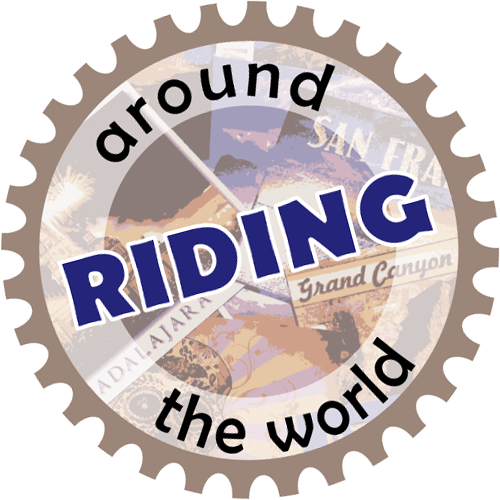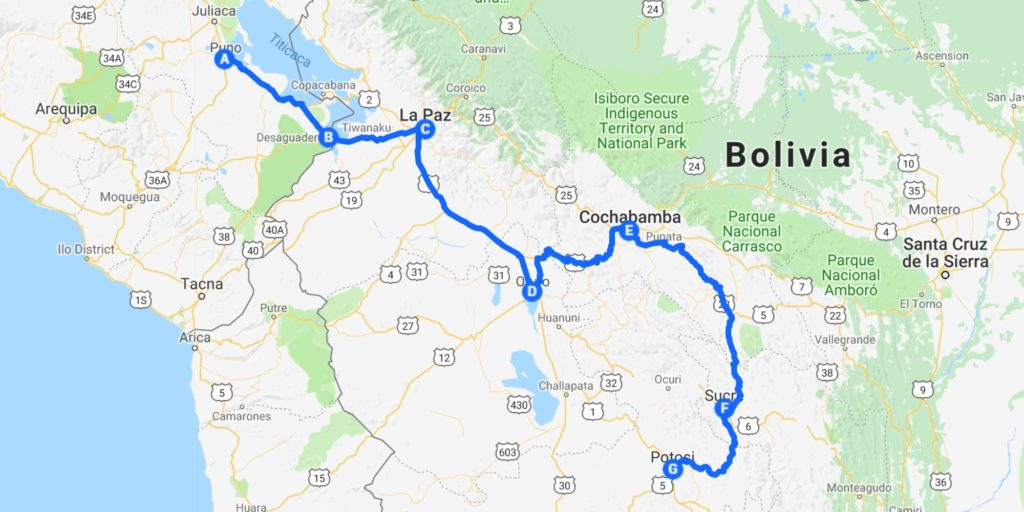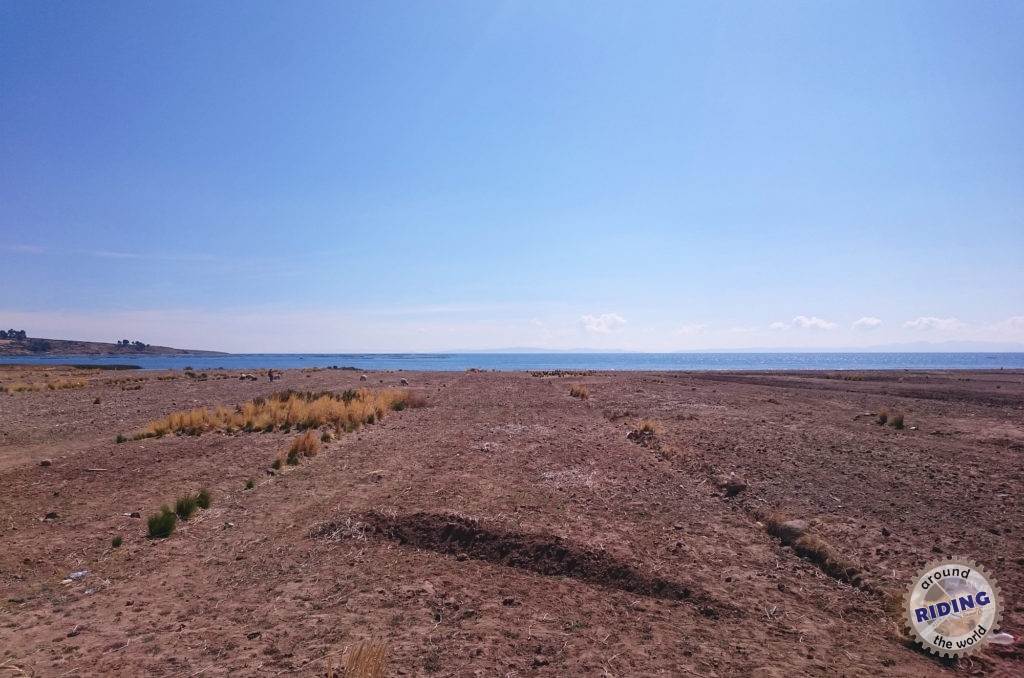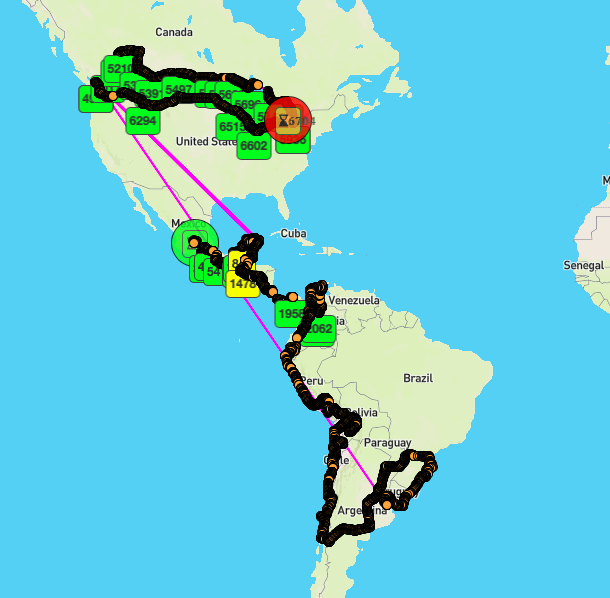On Tuesday, October 2, we had a 2-hour ride from the town of Puno to the border crossing for Bolivia. We stopped on the way to take a look at Lake Titicaca, but we didn’t have a good viewpoint and just our cell phones so we didn’t the greatest picture. Boo hoo for us. Lake Titicaca is a large, deep lake on the border of Peru and Bolivia in the Andes that happens to be the largest in South America and that is often touted as the “highest navigable lake” due to its surface elevation of 3,812 meters.
Getting to the proper building to do the procedures for the crossing took a bit of time because, unsurprisingly, there were no signs and Google Maps likes to take us around in circles before we can get anywhere. However, once we found the building, the process was easy and fast as the processes for both countries were done in the same building. We were in and out in 45 minutes. See our Border Crossings page for details.
The first stop in the 13th country of our trip was in La Paz, the administrative capital of Bolivia. The ride was another 2 hours from the border and the entry into the city was another frustrating one after Lima because not only do Bolivians drive just as badly as Peruvians, we got quite a bit of rain in what was an incredibly hilly city. Not a fun combination. Also, I couldn’t help but find the name of La Paz (Spanish for “peace”) to be quite the misnomer for a such a bustling city that teeters on the brink of chaos. However, despite the traffic and rain, we made it to our apartment without incident.
We spent five days in the city and enjoyed it more than we expected to. Our apartment was conveniently located close to many things, including the city’s impressive cable car system that we were happy to take advantage of when going to the city center. Yes, the cable cars are part of the city’s public transportation network and it is absolutely ingenious. It’s a wonder why all cities with bad traffic not have such a system. The city center itself was nice with numerous historical buildings, street art, and stores. We even passed by the infamous Witches’ Market which didn’t really pique our interest, but that is because we don’t have much use for things like dried llama fetuses. We ended our day with a walk to Mirador Killi Killi for some panoramic views of the city.
After La Paz, we set our sights on Cochabamba, but since that is a 6.5 hour ride, we split the ride over two days, adding a stop in Oruro. It used to be a silver mining center aeons ago, but now the mines are exhausted and the city itself is nothing special. However, our arrival coincided with a carnival that had been going on all day and that made getting to our hotel, which was in the center of the city, a bit of a challenge.
Once we made it and got settled in, we went outside to check out the carnival with everyone else, quickly got our fill with the dense crowds, and then returned shortly afterwards to enjoy it from indoors as we had a great view from our hotel. It was a delight to watch with all the creative and colourful costumes, music, and dancing. How those people were able to jump around and dance for hours on end at an elevation of over 3,700 meters is beyond me. Maybe they all have extra lungs and keep it a secret.
On the following day, we rode the rest of the way to Cochabamba where we stopped for two days. Unlike the rest of the places we had visited in Bolivia thus far, this city was on the warmer side and with a much lower altitude at 2,558 meters. Due to its mild climate and fertile productive soils, the area has been inhabited for thousands of years. The bit of history about this city that I like the most dates back to 1812, when it was the site of the riot against the Spanish Army. May 27 was the day that thousands of women took up arms against the Spanish, resisting with battered tin guns and arquebuses, fighting to the last yell. To honour their bravery, Mother’s Day in Bolivia is celebrated on May 27.
After Cochabamba, we made our way to the capital, Sucre. Before I start rambling about the city, you need to know that we rented the craziest apartment we could have imagined. With the price we paid, we were expecting something small and simple, just a decent place to lay our heads for the next two days. What we got, however, was a bachelor pad fit for a rapper. It was a big apartment with all the amenities for “hosting” a fairly large number of guests, but the best part was the lighting setup. From disco lights to laser beams in every colour of the rainbow, you can bet we had ourselves a little rave. And by “rave” I mean just the two of us dancing like fools to the Bee Gees. Of course we filmed it so you will have to keep an eye on our YouTube channel for that.
Now, back to Sucre. Founded in 1538, the city is the constitutional capital of Bolivia and is where the Supreme Court is located. We found it to be quite beautiful with all its churches and white colonial buildings. With an altitude only slightly higher than Cochabamba, the temperatures and walking around were pleasant. We didn’t have a set list of things to see and do, and instead, enjoyed discovering the city in our preferred manner; walking through the streets, people-watching, and eating some great food.
The last real city we visited in Bolivia before we headed towards the famous salt flats was Potosí. With an altitude of around 4,000 meters, this was the highest city that either one of us had ever visited, and as a result, had never felt more out of shape in our lives thanks to the low oxygen levels. Potosí is the perfect place to visit if you’ve ever wanted to feel like your heart is about to explode as you walk uphill at a normal walking pace. Aside from the ridiculous altitude, the city is famous for silver mining. Unlike Taxco, the city in Mexico that is also known for silver, Potosí’s streets are not lined with stores selling every item that could possibly be made out of silver.
The scars left by the Spanish in Bolivia run deepest in Potosí because it used to be one of the wealthiest cities in the world due to its silver production. The Spanish began large-scale excavation of the silver around the time the city was founded in 1545 and Potosí’s silver eventually became the foundation of the Spanish Empire. However, when Bolivia achieved independence in 1825, its silver mines were nearly exhausted and the fall in silver prices hurt the city’s economy such that it never completely recovered. Today, the mythical wealth of Potosí is only evident in the expression vale un Potosí (“to be worth a Potosí”) referring to someone who is exceptionally rich. The silver mines are still in operation and even offer tours, but we strongly discourage partaking in them. Not only are the miners’ working conditions extremely poor, it is simply not worth the risk.
Bolivia was not a country that we expected to like, let alone fall in love with. Not only were we entering the country at the start of the rainy season that many say makes for miserable travelling, riders who had traversed the country before us warned us about the terrible roads. And we truly believe that everyone’s account of Bolivia was genuine; however, I think that we were extremely lucky to have visited when we did.
We did get some rain throughout the duration of our stay, but it was too negligible to have a negative impact on our stay. As far as the roads go, save for a short section of manageable gravel between Oruro and Cochabamba, we got excellent tarmac roads throughout our travels in Bolivia. Locals informed us that the road infrastructure had seen a significant improvement over the last five years. We saw the old dirt and gravel roads and shuddered at the thought of travelling through them as riders before us must have done. With the improved infrastructure, and the incredible cities and people, we had a terrific time in Bolivia and highly recommend it as a travel destination.





